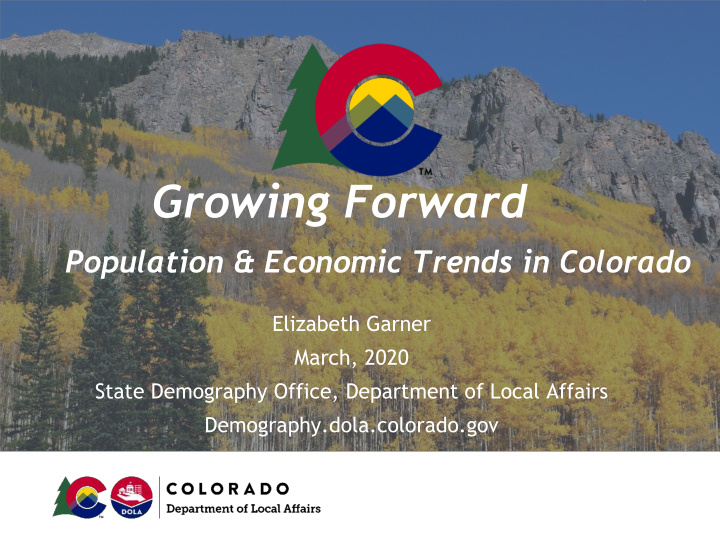



Growing Forward Population & Economic Trends in Colorado Elizabeth Garner March, 2020 State Demography Office, Department of Local Affairs Demography.dola.colorado.gov
Transitions to Watch • Population growing at a slowing rate • Concentrated growth • Migration – attracting and retaining the best and brightest. • Aging – impacts everything… including the economy, education, housing, transportation. • Increase racial and ethnic diversity.
Big Picture – 2018-2019 Pop Change • US – 328.2 million, + 1.5 million or .5% Slowest annual growth rate since 1918 • Slowest decade growth rate since data started being • collected • Colorado - - 5,758,736 Ranked 8th fastest 1.2% - ID,NV,AZ,UT,TX,SC,WA • 7th in total growth 67,449 – TX,FL,AZ,NC,GA,WA • Growth of 725,000 since 2010 • Eagle + 3,000 •
Peak Births – 2007. Currently 12-13 years old Peak Millennial Born in 1991 and is 28-29 years old 175,000 more women 15-45 in 2018 than in 2007 525,000 fewer births in 2018 than 2007 for the US, 7,000 fewer in Colorado
Eagle County Births and Deaths 1,000 900 36% drop in births to Eagle County 800 women from 2009 to 2019 700 600 500 400 300 56% increase in Deaths 200 from 2009 to 2019 100 0 1990 1991 1992 1993 1994 1995 1996 1997 1998 1999 2000 2001 2002 2003 2004 2005 2006 2007 2008 2009 2010 2011 2012 2013 2014 2015 2016 2017 2018 2019* Eagle Births Eagle Deaths
Colorado
Eagle County
Migration Statistics • In migration ave/yr 170,000-230,000 • Out migration ave/yr 150,000-190,000 Compared to CO average, In- migrants are: • Younger • Lower Income • Higher educational attainment
Inbound Counties Outbound Counties Net Migration 214 Delta Denver 370 Denver -267 205 San Diego, CA Jefferson 261 Jefferson -225 195 Larimer Garfield 224 El Paso -116 191 Lake Pitkin 224 Garfield -96 165 Custer Summit 124 Summit -96 152 Pitkin El Paso 123 San Diego, CA 205 128 Garfield Larimer 115 Delta 214
Jobs Are People
ACS 2013-2017
+ 665 Jobs Q3 2018-19
Where Eagle Workers Live and Distances they Commute
Where Eagle Residents Work and Distances they Commute
Age Matters • Preferences – where people shop and what they buy. • Housing – type, size, mobility • Labor Force • Income • Service Demands
Age Distribution by Generation Median Age = 37.5 Median 37.4
Aging Fast Because we are Young 6 th Youngest State, 3 rd fastest growth in 65+ • 2015-30 increase 65+ 711,000 to 1,200,000 • Economic Driver • Impact on occupational mix. Growing at 5% per year. Wages/Income • Labor Force – growth in retirees • Worker vs. non-worker mix changing • Housing – primarily home owners • Income – Downward Pressure • Health/Disabilities • Transportation • Public Finance – Downward Pressure •
Migration increases Slower growth Continued aging
0 to 17 18 to 24 25 to 44 45 to 64 65 to 100 Total Change (1,079) 1,025 1,517 1,418 3,186 Pct Change -8.9% 23.1% 8.3% 10.2% 63.2%
Ethnicity and Race
D IVERSITY B Y A GE Hispanic, Black, Asian, and other minority share 2015 2050 60% 58% 57% 52% 50% 58% 43% 43% 40% 38% 57% 33% 30% 32% 23% 20% 16% 10% 0% <18 18-24 25-44 45-64 65+
Educational Disparity Impact • Supply of qualified workers • Increase in need for importing workers • Income – correlation to education • Economy – 70% driven by consumer expenditures • Homeownership – wealth
Population Forecast
State – 2.4 million Front Range – 2M Denver Metro – 1M North FR – 600K South FR – 400K Rest of State – 400K
Population and Job Forecast 2015 2020 2025 2030 2035 2040 Growth 15-25 DIRECT BASIC JOBS TRADITIONAL 263 2,091 2,187 2,354 2,518 2,663 2,803 REGIONAL & NATIONAL SERVICES 868 3,369 3,958 4,237 4,491 4,748 4,928 TOURISM 1,685 16,288 17,678 17,973 17,942 17,671 17,619 COMMUTING JOBS -62 641 630 579 450 313 114 RETIREE GENERATED JOBS 1,954 1,690 2,732 3,644 4,290 4,918 5,477 PUBLIC ASST. GENERATED JOBS 111 482 543 593 619 635 630 INVESTMENT INCOME & WEALTH 648 2,858 3,307 3,506 3,695 3,904 4,147 NON-BASIC RESIDENT SV. JOBS 1,756 12,423 13,094 14,179 15,069 16,111 17,280 7,223 TOTAL JOBS 39,843 44,129 47,066 49,075 50,964 52,999 CIVILIAN JOBS (DEMAND) 7,320 39,701 44,084 47,021 49,030 50,919 52,953 JOBS HELD BY RESIDENTS 6,804 36,904 41,118 43,709 47,557 50,733 53,537 LABOR FORCE (RESIDENTS) 5,750 32,692 36,098 38,442 41,900 44,753 47,216 6,076 POPULATION 53,840 56,194 59,916 63,912 67,740 71,273
Risks to the Forecast +/- • Housing – supply, price, type, location – 5 th highest MHV • National Growth – National Policies – Intl’ immigration • Water • Infrastructure/Transportation • State Budget/Policy • Aging – labor force, prepared labor force • Industry changes – boom/bust, competitiveness. • Natural disasters/climate - nationally
Summary Trends • Population Growing but slowing – • Slowing Births, increasing deaths, slowing intl migration. • Concentrated growth – impact on West Slope? • Migration – how do we continue to attract and retain the best worker for the right job • Aging – fastest growing market • Race and ethnic diversity increasing – growing market • Foundation based on good data and information
• Representation • Distribution of Federal Funds - $13 billion in Colo. • Inform state and local decision-making • 10 questions, 10 minutes, online, phone, paper, in person • All respondent data and information is protected by law.
Colorado Census Website colorado.gov/census2020
Thank you State Demography Office Department of Local Affairs Elizabeth Garner Elizabeth.garner@state.co.us 303-864-7750 Demography.dola.colorado.gov
10 questions directed to the householder and to each person living in a household. Name • Phone Number – Just for Census use if necessary. • Age • Hispanic Origin • Race • Relationship to householder • Sex • Tenure – own/rent • Number of persons in household • Does the person usually stay or live somewhere else? •
Recommend
More recommend